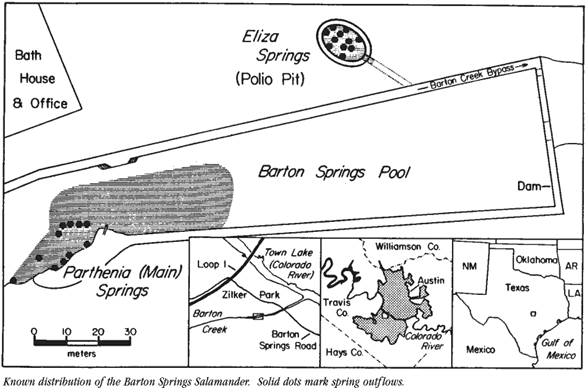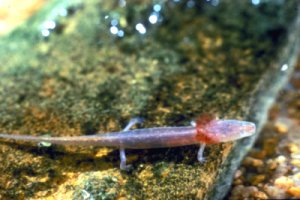Barton Springs Salamander (Eurycea sosorum)
- Texas Status
- Endangered
- U.S. Status
- Endangered, Listed 4/30/1997
- Description
- A slender, long-limbed salamander, about 2.5 inches in total length, with a small narrow head and greatly reduced eyes. They vary in color, and can be dark gray, gray, purplishgray, gray-brown, or yellowish-brown. Most individuals have a dark "salt-and-pepper" mottling on their back. These salamanders have external gills which are red in color. The Barton Springs Salamander is entirely aquatic throughout its life.
- Life History
- Although relatively little is known about the biology of the Barton Springs Salamander, new information is rapidly becoming available. Recently hatched young have been found in November, March, and April, and females with well-developed eggs have been found in September through January. They are known to eat amphipods (tiny aquatic crustaceans) and other small, aquatic animals. Captive specimens feed on amphipods, earthworms, white worms, and brine shrimp.
- Habitat
- The Barton Springs Salamander occurs only at the spring outflows of Barton Springs. These are often found under rocks or in gravel in water several inches to 15 feet deep. They can also be found hiding in aquatic plants and algae. They rely on a clear, clean, continuous flow of spring water. The Barton Springs Salamander is clearly capable of living underground, but also inhabits surface environments. Although not known for certain, some scientists believe the salamander is primarily a surface-dweller that is adapted for life underground when surface conditions become unsuitable. salamanders
- Distribution
 Spring outlets at Barton Springs in Austin, Texas.
Spring outlets at Barton Springs in Austin, Texas.- Threats and Reasons for Decline
Because the Barton Springs Salamander relies on the clear, pure water of the Barton Springs Aquifer, protection of the quality and quantity of water flowing from Barton Springs is essential for its survival. Threats to water quality such as urban runoff, increased development in the Barton Creek watershed, and the risks of a toxic chemical spill or sewer line breakage in the urban zone surrounding Barton Springs remain a concern. Also of concern are reduced groundwater supplies due to increased urban water use.
Prior to 1989, aquatic plants were abundant in Barton Springs Pool. Surveys in the early 1970s showed that the Barton Springs Salamander was quite abundant, and many could be found by searching through submerged leaves in Eliza Springs. From 1970 to 1992 the population of this species dropped sharply. We now know that certain pool maintenance practices, such as the use of high-pressure hoses, hot water, and chemicals were harmful to the salamanders and the aquatic plants in the pool and nearby spring outlets that provide their habitat. Today, the pool is maintained in ways that minimize damage to the salamander and its habitat. The City of Austin's Environmental and Conservation Services Department also has planted aquatic vegetation in the deep end of the pool to restore habitat and more plant restoration is planned for this area. Since the new pool maintenance practices began, the habitat in the pool and nearby springs has rapidly improved. Although the salamander has expanded into its former range in the Barton Springs Pool, scientists believe it probably has not reached the extent of its pre-1970 distribution.
Residents and visitors to Austin will be happy to know that swimming in Barton Springs Pool does not pose a threat to the salamander or its habitat. With proper management, the pool will continue to provide refreshing enjoyment for people and habitat for the Barton Springs Salamander.
- Ongoing Recovery
The population level of the Barton Springs Salamander will be routinely monitored to assess the effects of new pool maintenance practices and other factors impacting the habitat. Austin's Parks and Recreation Department has established an advisory team to review and coordinate all pool maintenance procedures that could affect the Barton Springs Salamander.
The City of Austin is conducting monthly surveys to assess the population status of the salamander at each of the four springs where the salamander is known to occur. Finally, research is underway to better understand the life history and habitat needs of this species. The City of Austin is currently working to acquire land in the Barton Springs contributing and recharge zones through purchases and conservation easements. Over 15,000 acres of open space have already been protected. These acquisitions will protect the salamander through the preservation of open space, and therefore, protection of water quality. The Austin Nature and Science Center has developed an outreach program that involves activities designed to educate the public about the Barton Springs salamander and its habitat. The Center also directs the SPLASH! Exhibit to raise public awareness about the Edwards Aquifer. Finally, City of Austin biologists are currently working to develop methods to increase the accuracy of salamander population estimates.
- How You Can Help
Keeping our springs, creeks and underground water clean benefits the people and wildlife of the Austin area. Lawn and agricultural chemicals and pesticides should be used sparingly and only according to label directions, particularly within the recharge zone of the aquifer. Carefully follow recommended procedures for disposing of containers and rinse water. Take used motor oil to auto maintenance businesses that can use or dispose of it properly. Be careful with household chemicals and dispose of the containers according to label directions. The City of Austin has a designated drop off location for hazardous household material. Call the Household Hazardous Waste Collection Facility at (512) 416-8998 for more information. Keep trash and other pollutants out of our natural waters.
Do what you can as an individual to conserve water, particularly during drought periods. In the home, you can save water by installing fixtures, appliances, and toilets designed to use less water, repairing leaky faucets, and turning off the tap while brushing teeth or doing dishes. Landscaping with native, drought tolerant plants (xeriscaping), watering lawns in the evening or early morning to reduce evaporation, and installing a rainwater collection system for your home, are other effective ways to conserve water.
The Barton Springs Salamander is dependent on vegetation to provide food and cover. Do not pull up or otherwise damage aquatic plants at Barton Springs. Also, exotic species often pose significant threats to native wildlife and plants, including listed species. Do not release aquatic animals or plants into waters they did not come from originally.
Soil erosion and runoff which causes siltation of streams is a serious threat to water quality and a healthy aquatic ecosystem. Management of surface vegetation is the key to preventing soil erosion and runoff, and encouraging rainfall infiltration and aquifer recharge.
Finally, you can support the city's efforts to protect the salamander by being tolerant of changes that are occurring at Barton Springs Pool. Swimmers can continue to enjoy a more natural Barton Springs Pool and the ecosystem of plants and animals, including the salamander that it supports. Visit Zilker Park in Austin to learn more about the Barton Springs Salamander.
